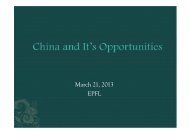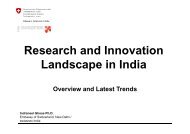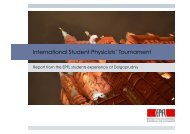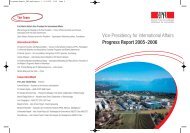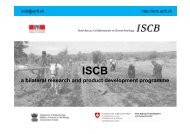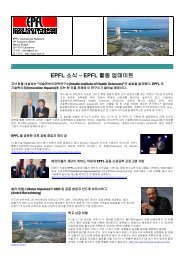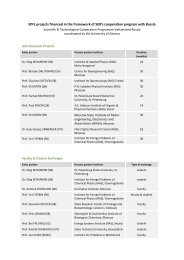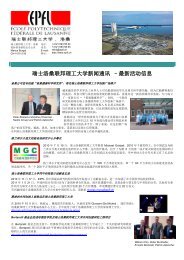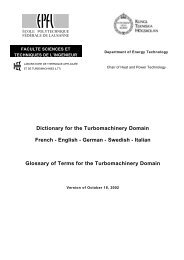Science & Technology News from Japan - International Relations
Science & Technology News from Japan - International Relations
Science & Technology News from Japan - International Relations
You also want an ePaper? Increase the reach of your titles
YUMPU automatically turns print PDFs into web optimized ePapers that Google loves.
Schweizerische Eidgenossenschaft<br />
Confédération suisse<br />
Confederazione Svizzera<br />
Confederaziun svizra<br />
Embassy of Switzerland in <strong>Japan</strong><br />
State Secretariat for Education and Research SER<br />
Multiple Chemical Sensitivity-Awareness<br />
(March 02, 2009)<br />
One <strong>Japan</strong> study conducted by Kyoto University's graduate school, along with others, estimated that as many as<br />
700,000 adults could potentially have “Multiple Chemical Sensitivity” (MCS) syndrome. It is a condition in which a<br />
person experiences headaches or other symptoms in response to exposure to certain chemicals. Three prefectural<br />
governments and 21 city and town governments are staging public awareness campaigns. The debate extends to<br />
what kind of paint to use when renovating a school. Sick building syndrome, triggered by volatile organic compounds<br />
and other chemicals used in architectural materials, paint and other substances, is a form of MCS.<br />
Smokers Two Times More Fragile For Noro-Virus<br />
(March 03, 2009)<br />
Smokers who were exposed to a noro-virus at a hospital in Gifu Prefecture three years ago had an infection rate<br />
twice that of nonsmokers also exposed, an investigation by the hospital has revealed. A total of 127 patients and<br />
staff at Nozomi no Oka Hospital were infected with the noro-virus between October 2005 and February 2006. The<br />
hospital looked into how the infection spread and concluded that the higher rate of infection among smokers was<br />
due to finger-to-mouth contact with the virus facilitated by smoking. 67% of staff at the three wards and 55% of the<br />
staff at the annex were infected. The infection rate of nonsmokers was only 36% and 26%, respectively.<br />
<strong>Japan</strong> Behind US In ES Cell Tech Research<br />
(March 04, 2009)<br />
<strong>Japan</strong> will start drawing up rules covering regenerative therapy using human embryonic stem cells this month. The<br />
nation is already behind the United States, where the world's first clinical trials for such therapy begin this summer<br />
using a method that involves injecting ES cells into people with spinal cord damage. Okayama University has urged<br />
the government to use the U.S. model on the application of ES cells as a reference to help expedite the drawing up<br />
of rules covering ES cell use in medical treatment here.<br />
Cells Cultured In Artificial Matrix<br />
(March 05, 2009)<br />
Sumitomo Bakelite Co. has begun marketing a kit that can be used to culture cells in 3-D multilayer matrices without<br />
the use of animal-derived bio molecules. The kit is based on work carried out at Osaka University, where scientists<br />
developed a means of culturing 3-D cellular matrices by growing layers of cells separated by films that serve<br />
as cell-adhesive sheets. But these films are made <strong>from</strong> fibronectin and gelatin, which are both proteins of animal<br />
origin. To eliminate inconsistencies and the risk of contamination with infective agents, Sumitomo Bakelite used its<br />
polymer processing technologies to develop an artificial substitute.<br />
L’Oreal-UNESCO Award For First Female Professor At Tokyo University<br />
(March 06, 2009)<br />
Prof. Akiko Kobayashi is one of the recipients of the 2009 L'Oreal-UNESCO Awards for Women in <strong>Science</strong>, along<br />
with four other scientists <strong>from</strong> five continents, becoming the third <strong>Japan</strong>ese to win the prize. The L'Oreal-UNESCO<br />
Awards were established in 1988 to honor female scientists who have made outstanding contributions to science.<br />
Kobayashi succeeded in using single-component molecules to develop the world's first molecular crystal that conducts<br />
electricity--a characteristic feature of metals. Many believed this was an impossible task. Kobayashi made<br />
history when, at the age of 55, she became the first female professor at Tokyo University's school of science.<br />
First Time Mapping Of Termite Intestinal Bacterium Genome<br />
The Institute of Physical and Chemical Research (RIKEN) has succeeded for the first time in<br />
mapping the genome of a bacterium that lives in the intestines of termites. These results<br />
bring scientists a step closer to developing a biofuel <strong>from</strong> wood biomass. This study succeeded<br />
in mapping the complete genome of Rs-D17, a bacterium that lives in the cells of<br />
Trichonympha (T. agilis), a protist inhabiting the intestine of the <strong>Japan</strong>ese subterranean termite.<br />
RIKEN’s Advanced <strong>Science</strong> Institute isolated a single cell of T. agilis and collected<br />
several hundred Rs-D17 by rupturing the cell membrane.<br />
(March 06, 2009)<br />
Modified Analyzer For Blood Sugar Marker<br />
(March 06, 2009)<br />
Hitachi High-Technologies Corp. has modified its fully automated biochemical analyzer to test for a blood sugar<br />
marker when it measures for other metabolic syndrome indicators in the blood, such as cholesterol and lipids. The<br />
result is a machine that is both labor- and space-saving, since it eliminates the need for separate steps and separate<br />
equipment to isolate and test for this marker, known as HbA1c, <strong>from</strong> the blood sample. To integrate this task<br />
<strong>Science</strong> & <strong>Technology</strong> <strong>News</strong> <strong>from</strong> <strong>Japan</strong>, Template 2009 • Felix Moesner, <strong>Science</strong> & <strong>Technology</strong> Attaché Page 4 of 28





